AN ODE TO TOHOKU
The Tohoku region of northeastern Japan has always been a trove of folklore and culture. Now world famous for bearing one of the worst disasters in modern history, the region is already giving birth to new legends of supernatural forces and heroic survival and recovery. Here’s a whirlwind tour, from north to south, of Tohoku magic which Tokyo-based freelance journalist Christopher Johnson discovered during more than 10 trips to the disaster zone in 2011.
Below is a collection of original photos and stories that appeared in the Washington Times, the Toronto Star, the Globe and Mail, the Asia Times, the Japan Times, CNNGO.com and others
TARO
(https://globalitemagazine.com/2011/07/15/japan-taro-town-model-of-recovery-in-japan/)
http://www.washingtontimes.com/news/2011/jul/4/tsunami-drill-saved-japanese-t…
Tsunami stones, drills saved Taro from fate of 1989, 1933 disasters
A tsunami in 1896 killed all but 36 residents of Taro, and 911 died in 30-foot high waves in 1933. But this time, Taro was perhaps the best-prepared town on the northeast coast, and it was among the fastest to build temporary shelters and organize a new life for survivors. Famous in Japan for harvesting seaweed, urchin and abalone, Taro holds tsunami escape drills every March 3 on the anniversary of the 1933 disaster.
MIYAKO area
(https://globalitemagazine.com/2011/09/11/japan-go-to-tohoku/)
http://www.japantimes.co.jp/text/fv20110911a1.html
Miyako quickest to recover, with bustling downtown core a base for volunteers, rebuilders
Hardy locals were quick to hire staff and rebuild hotels and restaurants to welcome visitors, whether they are volunteers, aid workers or travelers aiming to raise their awareness of the plight of disaster victims and spend badly needed money in the local economy.
YAMADA
http://www.washingtontimes.com/news/2011/may/30/pubs-grocery-stores-first-to-…
Pubs, grocery stores first to come back
Katsunori Buto is glad he didn’t tear down that old warehouse. Though the tsunami wiped out his home and neighbourhood, the old warehouse held its ground, and became one of the first Japanese shops to reopen. Amid the debris of upended ships and pulverized buildings, it’s a community centre, where seniors push little carts to stock up on supplies and gather the latest information.
OTSUCHI
(https://globalitemagazine.com/2011/05/06/photos-of-otsuchi-area/)
(https://globalitemagazine.com/2011/06/08/japan-spirits-protected-temples-from-tsunami-and-fires/)
http://www.washingtontimes.com/news/2011/jun/8/magic-temple-soothes-tsunami-s…
The magical temples amid the floods and fires
For many locals who come to worship here, the temple seems to have magical powers. The March 11 tsunami rushed up a slope to the steps of the temple grounds and then turned back, dragging thousands of people and buildings with it back into the ocean. After that, an inferno of exploding fuel from canisters, cars and gasoline stations engulfed most of the town, where local officials last summer said they could confirm the whereabouts of only about 6,400 of the town’s 15,000 residents. Though flames leapt up the mountainside and scorched the trunks of trees encircling the temple grounds, the fire stopped before reaching the main wooden shrine — which has been periodically rebuilt, according to Shinto custom, for more than 1,000 years.
Wanted: a new generation to build Otsuchi
http://www.washingtontimes.com/news/2011/jun/27/wanted-a-generation-to-rebuil…
Many of Otsuchi’s most energetic people, between the ages of 30 and 60, were lost in the 50-foot-high tsunami and fire that gutted almost every building in town. “They were the brightest young people in town, and now they are gone,” Mr. Goto said of his former students. Goto and others want youth to come back.
KAMAISHI
http://www.cnngo.com/tokyo/life/tohoku-disaster-real-life-drill-tokyo-police-…
Tokyo police, working in Tohoku, learned how to save lives when the next Big One hits
Across northeastern Japan, a massive three-day search mission in the spring, involving 18,000 Japanese and 7,000 U.S. troops, plus firefighters and police officers from across Japan, could find only 77 corpses out of more than 15,000 people registered as missing.
Many Tokyo-based police officers were sent north to rescue people and search for bodies in the zones affected by the tsunami and nuclear disasters in northeastern Japan. “This is good practice for us,” says Yoshito Shinbori, the commander of a Tokyo-based unit searching for missing persons in Kamaishi, Iwate Prefecture. “Someday a big quake and tsunami will hit Tokyo, and this will help us prepare for that reality.” To help Iwate’s 2,000 exhausted officers, who are also coping with personal losses, the Tokyo Metropolitan Police Department dispatched more than 200 officers out of a metropolitan force of 45,000 — perhaps the largest in the world.
OFUNATO
The elderly couple with the tugboat in their yard
http://www.washingtontimes.com/news/2011/oct/21/japanese-couple-stuck-giant-t…
An elderly couple here are learning to live with a strange lawn ornament dumped in their front yard seven months ago in the tsunami that devastated Japan’s northeast coast. A 230-ton tugboat that is high and wide enough to cast a shadow over their house has become a tourist attraction, but Kinichi Oikawa, 82, and his wife, Shizuko, 80, want the boat owner to get the vessel off their property. The owner of the Kazumaru No. 1 tugboat, which used to fight fires and haul massive freighters around the Ofunato harbor, cannot afford to move it.
Fish market model: Provide jobs, and towns will recover
http://www.washingtontimes.com/news/2011/sep/5/fish-market-restored-following…
Ofunato’s fish market was under 50 feet of water on March 11, the day the tsunami struck. Now it is thriving – partly because of the tsunami and the restoration efforts of hundreds of workers and partly by volunteers who reopened the devastated port in May. Ofunato’s fish market is bustling again with fishermen offloading their catch and buyers hollering out bids. “I’m happy to have a job again,” said Mrs. Tada, 52, working among scavenging birds and about 300 sweaty men unloading nets or stabbing fish with ice picks.
Painting disaster in brilliant colours
http://www.washingtontimes.com/news/2011/sep/16/survivors-add-color-japan-gho…
http://www.washingtontimes.com/multimedia/collection/survivors-volunteers-add…
In the morbid gray tones of the disaster zone in northeastern Japan, a colorful barber shop stands out above the fields of debris in this port town. With the help of foreign and Japanese volunteers, and the fruitful imagination of painter Kensuke Miyazawa, Mr. Shimizu turned what could have been an ugly aluminum structure into a beacon of hope amid the rubble.
Like the storytelling artwork of Buddhist temples across Asia, the wall paintings on his barber shop depict scenes of the activities of the smiling volunteers themselves. One wall bears the name of each volunteer. “It’s colorful, and it makes people smile when they see this,” said Mr. Shimizu. “I want people to believe that we can rebuild this into a bright, beautiful community for our children.”
RIKUZEN-TAKATA
(https://globalitemagazine.com/2011/04/29/japan-photos-of-rikuzen-takata/)
The Tree of Hope, and a Lack of Monuments
http://www.washingtontimes.com/news/2011/sep/9/6-months-japan-disasters-sunfl…
The Tree of Hope stood alone, the sole survivor out of 70,000 black and red pines on a barrier island swallowed whole by the Pacific Ocean on a gloomy Friday afternoon on March 11. Most of the hardy survivors, who now live in small temporary houses on high ground above their obliterated city, have never seen the tree. Many are not interested in talking about it.
Having lost relatives and most of their material world, they are still too distressed to even look at the massive reconstruction efforts going on in a disaster zone stretching more than 300 miles along Japan’s northeastern Pacific coast. “I don’t go there because it’s difficult to figure out where I am,” said Emi Sato, 34, who lost her home and many relatives in Rikuzen-Takata, and now lives with her husband’s family in Ofunato. “In the night it’s totally dark, and it’s scary even during the day. There are many accidents, and no street signs. I’m too afraid to go there again.”
The Home Where the Tsunami Finally Stopped
http://www.washingtontimes.com/news/2011/apr/4/the-home-where-the-tsunami-fin…
Unlike other disaster areas where untouched high ground has become hubs for local aid efforts, the devastation of Rikuzen-Takata spreads far beyond the city of 25,000 and into the river valley — even to the old farmhouse of Mr. Suzuki’s parents in the town of Yahagi. For centuries, the Suzukis and other farmers of Yahagi thought they were safe from the sea, more than five miles away beyond mountains that shielded their crops from sea salt, wind storms and tsunamis that battered the coast.
On March 11, five miles wasn’t enough. In a span of about six minutes, a deluge uprooted seaside red pines and carried them over four-story shopping centers and apartment complexes. Spilling into the Kesen River, the tsunami knocked over bridges and railways, then snaked around the mountains into the rice paddies in Yahagi, where it dropped the pines beside poems carved in ancient stones. Surging uphill, the tsunami rushed all the way up to the Suzukis’ garden, drowning winter crops of cabbages and broccoli, ripping apart greenhouses, and soiling the inside of their traditional farmhouse. Then, in front of their eyes, the tsunami turned around, sparing them from the obliteration all around.
The most beautiful junior high school in Japan
http://www.washingtontimes.com/news/2011/apr/5/japan-school-a-sanctuary-on-hi…
Its stairwells and hallways lined with cedar, the Rikuzen-Takata No. 1 Junior High School is one of the most beautiful and well-kept in Japan, especially in contrast to the obliterated city below, where the March 11 tsunami shredded every wooden structure. More than 1,000 survivors crammed into unheated classrooms and a gymnasium, using curtains as blankets, but the school bears a remarkable freshness.
KESENNUMA
Where did the sharks go from the Shark Museum?
(https://globalitemagazine.com/2011/03/29/japan-beautiful-kesennuma-city-of-debris/)
http://www.wheels.ca/article/asset/794792
While crews have gathered debris into massive piles across the tsunami zone, the wreckage around the Shark Aquarium in Kesennuma has barely been touched since the March 11 tsunami. “Most people are still too scared to even come down here and look at this,” says Takeshi Utsumi, whose downtown electronics shop was swept away along with most everything else in the low-lying half of Kesennuma in Miyagi prefecture. “We can’t even begin to think about rebuilding our lives here.”
The little noodle shop of hope
http://www.washingtontimes.com/news/2012/jan/6/japan-tsunami-survivor-goes-ho…
Running a business in a battered economy in a tsunami-ravaged community is an exercise of hope and redemption for one man with a noodle shop. “There’s a risk in starting a business now in a terrible economy in a disaster zone,” Yasuhiro Ishiwata, 28, said in his shop in this seaside town that was decimated in the March 11 tidal wave. “But compared to the tsunami, there’s nothing to be afraid of anymore. I’m starting to believe that there is such a thing as tomorrow.”
MINAMI-SANRIKU
(https://globalitemagazine.com/2011/05/06/photos-of-minami-sanriku/)
http://www.washingtontimes.com/news/2011/apr/28/japan-seeks-foreign-ideas-gre…
For more than 45 days, the Watanabe family, all eight of them, tried to make a tiny part of a school gym floor into their home. Having lost their 200-year-old farmhouse in the March 11 tsunami, they tried to keep their new “property” tidy, using cardboard boxes for “walls,” blankets for cushions and window sills to hang donated clothing.
Serving tea on a table found in piles of debris, they smiled to keep up appearances. But they said they could barely stand all the coughing and snoring around them. “It’s hysteria,” said the grandmother, Yoshie Watanabe, tired of kids running around. “We can never rest and think clearly here. The noise and the commotion never seem to stop.” Many U.S. soldiers, relief workers, volunteers and journalists who have seen the obliterated cities and towns of the northeastern disaster zone say privately that they are surprised at Japan’s slow pace of reconstruction. While international organizations quickly built temporary housing in Thailand and Indonesia only weeks after the 2004 tsunami, Japan is mainly trying to rebuild on its own.
ISHINOMAKI
Tennis club opens amid aftershocks, debris, asbestos risk
http://www.washingtontimes.com/news/2011/may/8/tennis-good-for-our-soul-and-m…
http://www.theglobeandmail.com/report-on-business/international-news/asian-pa…
In a sea of wreckage and chaos, the tennis courts were an oasis of order, providing a sense of calm to the club members who worked hard to clear away mud and debris after the March tsunami. As cranes sorted pulverized homes into hills of debris and soldiers and police in protective white suits search for corpses, tennis players whopped balls back and forth, oblivious to the apocalyptic scene around them.
On a sunny spring day, the smell of fresh balls and the squeaking of shoes reminded the survivors of how sweet and healthy life used to be on the northeast coast of Japan. “It feels great to play tennis again,” said Yoshihiro Kumemoto, smiling as he hits with his children and friends. “It’s good for our soul and mental condition. Tennis can help us overcome the depression that people feel since the tsunami.” Fed up with noisy, crowded shelters, Nobuko Honma, who runs the tennis club with her husband, moved into the clubhouse, where she sleeps amid vintage wooden rackets. “This is a quiet and peaceful place,” she said.
Japan’s luckiest survivor goes home
http://www.thestar.com/news/world/article/982838–japan-s-most-famous-survivo…
The last time Sumi Abe left home, a helicopter pulled her up from the rubble after she had been trapped with her grandson for nine days from the March 11 tsunami. Returning six weeks later, Abe, perhaps Japan’s most famous tsunami survivor, was alone on a bus, just another elderly woman in search of food, medicine and missing friends and relatives.
“I’m looking for my doctor,” she says, sitting by chance next to this reporter on a bus to her home in Ishinomaki, a city of 160,000 where more than 6,000 are registered as dead or missing. “Everybody is in a different place now than they were before.” Though using a cane for the first time, she insists on carrying her own bags. “I’m fine, but my hands and legs still ache, and my nerves are not so good,” she says, her skin wrinkled from her ordeal. “Imagine experiencing a tsunami like that at my age. I am 80 years old.”
Musicians learn to live at the bottom of the pyramid
http://www.washingtontimes.com/news/2011/aug/11/many-in-japan-learn-to-live-a…
Ishinomaki has perhaps the best chance for recovery, thanks to thousands of volunteers and hardy locals who refuse to abandon the battered city of 160,000. However, the local economy has barely grown since the tsunami destroyed its port and riverside areas. Yoshio Imamura, head of a local shop-owners association, said only seven of 32 business owners are trying to reopen their shops in the riverside entertainment district, normally buzzing with activity day and night. Instead, at least eight owners, who grew tired of sleeping in crowded shelters, are housing their families on upper floors of shops, above the tsunami damage on lower levels.
HIGASHI-MATSUSHIMA
Surfers show Japan how to get over the wave
http://www.washingtontimes.com/news/2011/apr/23/surfers-show-japan-how-to-get…
http://www.washingtontimes.com/news/2011/apr/17/displaced-japanese-youths-see…
Few people know more about the power of waves than the members of the Heavy Current Surfing Club.
When they saw the tide suddenly withdraw after a massive quake on March 11, they knew a huge tsunami was coming. They all fled the picturesque beach of this town in northeastern Japan to safety on higher ground. “We didn’t lose any members, because we respect and fear the ocean,” said Seiichi Kato, sitting by his surfboard and tent on the beach. “But other Japanese forgot about nature, and they could not escape it.” Instead of joining the mass of refugees in clammy, overcrowded shelters, Mr. Kato, Mr. Ohyama and their surf buddies pitched tents on the beach, where they cook by campfire.
NOBIRU
http://ja.wikipedia.org/wiki/ファイル:Nobiru_Elementary_School’s_gymnasium_2.jpg
(https://globalitemagazine.com/2011/04/20/japan-a-school-principals-do-or-die-decision/)
www.washingtontimes.com/news/2011/apr/21/japan-lives-lost-to-disaster-protocol/
A Principal’s Do or Die Decision
In Japan’s rigid education system, principals, teachers and students are supposed to follow official policy without question. So when a huge earthquake shook Nobiru elementary school for three minutes on March 11, Michiko Kishima, the school’s principal, didn’t march everyone up the road to the hills behind her school. Instead, sticking to official instructions, she herded about 350 people into the government-designated evacuation site — the school’s gymnasium — where many would drown or freeze to death on a night of terror which continues to challenge educators set to restart classes this Thursday.
In a village of 800, where officials say police have identified at least 260 bodies, many are questioning not only official preparations and decisions, but Japan’s education system as a whole, which teaches people to obey orders without the type of independent thinking that could have saved many lives across northeastern Japan. Yet others are praising the perseverance of Mrs. Kishima, 22 teachers, and about 70 heroic students whose quick thinking saved themselves and others during a 9-hour ordeal on March 11.
MATSUSHIMA
Tourists flock to Miracle Matsushima, where barrier islands saved ancient temples, trees
http://www.washingtontimes.com/news/2011/aug/17/matsushima-japan-japanese-tou…
(https://globalitemagazine.com/2011/08/19/japanese-tourists-returning-to-miracle-matsushima/)
Widely considered one of Japan’s “three great views,” the seaside resort town of Matsushima in Miyagi province, with pine trees studding 260 islands in a majestic bay, has long been known for its esoteric powers. Japanese poets as famous as 17th century haiku master Matsuo Basho have found inspiration here.
While nearby towns and cities remain devastated, Matsushima, which sits in the heart of a 300-mile-long swath of wreckage, is already welcoming a third of normal tourist arrivals, according to local tour operators. Many visitors are amazed to see the town’s hotels, seafood shops and thousand-year-old temples relatively unscathed. Small islands in the bay bore the brunt of 50-foot high tsunami waves from the open Pacific.
FUKUSHIMA
Youth ask themselves: Should I stay or should I go
http://www.washingtontimes.com/news/2011/sep/25/fukushima-japan-ko-saito-is-i…
Ko Saito is in his final year of high school in Fukushima and sees a bleak future for his native province. “I am very scared of the radiation,” the 18-year-old said while waiting with friends near the city’s train station. They discussed whether to stay or leave a region devastated by the meltdown of a nuclear power plant that was crippled by a killer tsunami six months ago. “I want to be tested [for radiation levels] to know more about my true physical condition, but they are not doing that yet,” he said. “I want to go to Sendai, because I fear radiation levels in Fukushima are higher than they are saying.”
Nuclear winter for Naoto Matsumura, the lone wolf of Fukushima forbidden zone
http://www.japantimes.co.jp/text/fl20111218x2.html
Living without electricity or enough money to fill his generators with gas, even as the mercury is already dipping below zero, Matsumura wonders if his neighbor’s supply of charcoal will be enough to keep him warm through the frigid winter in his corner of the once-thriving town of Tomioka that used to be home to 16,000 people.
He’s worried, too, that the hundreds of animals he’s been feeding since the area’s other residents were evacuated in haste on March 12 — some 400 cows, 60 pigs, 30 fowl, 10 dogs, more than 100 cats, and an ostrich — won’t survive to see another spring. “They need help from humans,” he says while lighting another of the 20-odd cigarettes he admits to smoking a day. “My supplies to feed them will be gone by the end of December. They need food, and buildings for shelter from the winter. I’m the only one taking care of everything. The government should do it, but I’m doing it.”
TOKYO
Could a monster tsunami hit Tokyo
http://www.cnngo.com/tokyo/life/could-monster-tsunami-hit-tokyo-one-day-321226
The city’s previous study in 2006 estimated a 7.3 quake in “north Tokyo Bay” could kill between 5,600 and 7,800 people, injure 160,000, trap 22,000, damage about 500,000 buildings, spark at least 300,000 fires and force 4 million people to evacuate.
The worst-case scenario is horrifying. Waves swamp Haneda airport and hurl freighters into Shinagawa office towers. Kawasaki chemical factories explode into toxic fires. Walls of water moving at jet speed pulverize, mangle or gut buildings and rise up to the fourth floor of the Japan Times in Shibaura. The tsunami rushes up the Edo, Arakawa, Sumida, Tama and Meguro rivers, past Naka-meguro and into the bowl of Shibuya. The reclaimed lands of Ota, Minato, Chuo and especially Koto wards — already below sea level in places — become an uninhabitable swamp, setting the economy back decades.
As unbelievable as it seems, that’s the Tokyo equivalent of what happened to Rikuzen-takata, Kesennuma, Minami-Sanriku, Ishinomaki and about 50 areas along a 500-kilometer swathe of Japan on March 11. In those areas, indented coastlines — which closely resemble Tokyo Bay from the air — pushed tsunamis up 10 meters higher than in other areas.
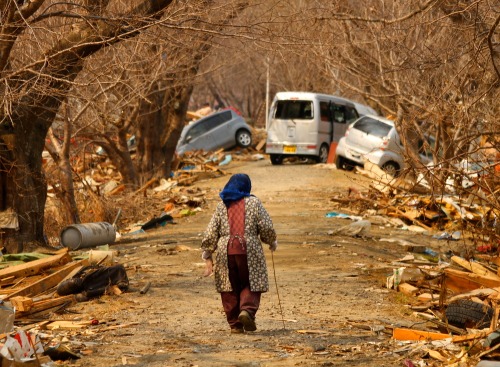

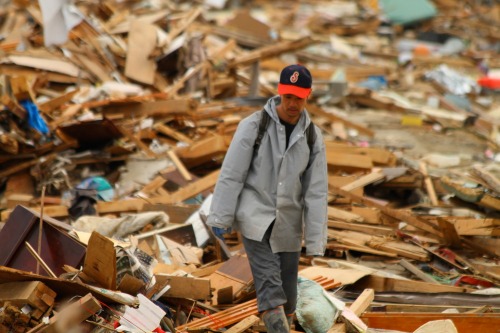










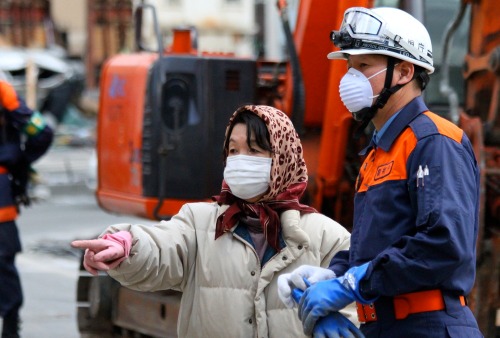

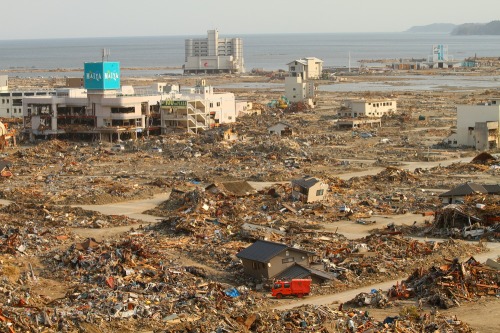




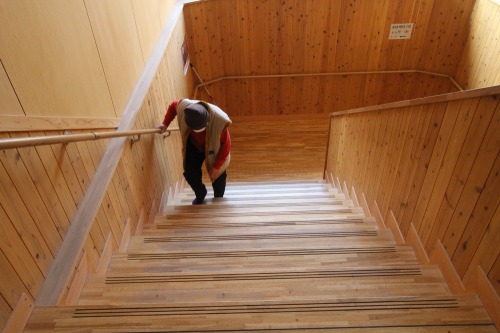

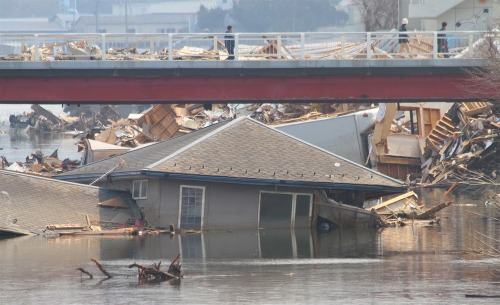
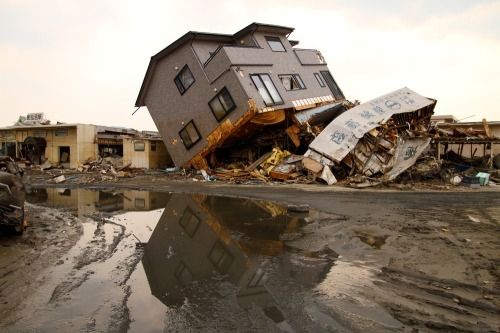


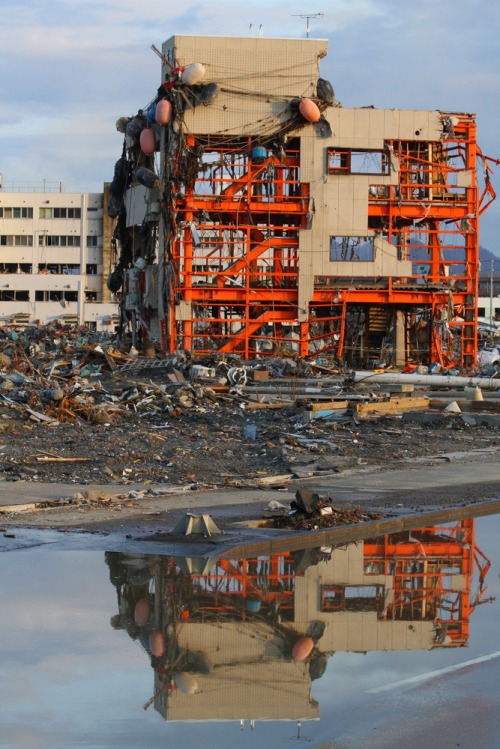








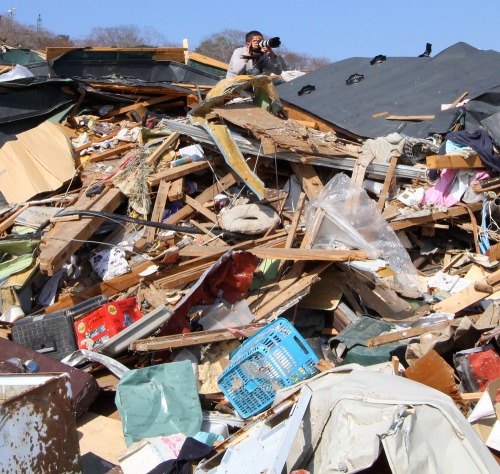


Pingback: Ethics and the “other freelancer” | Globalite Watchdog